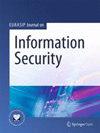基于 EPSO-BP 算法的网络安全威胁检测技术
IF 2.5
Q2 COMPUTER SCIENCE, INFORMATION SYSTEMS
引用次数: 0
摘要
随着互联网技术的发展,大量的网络节点和动态结构使得网络安全检测变得更加复杂,这就需要利用多层前馈神经网络构建安全威胁检测模型,提高网络安全防护能力。因此,采用熵模型优化粒子群算法对粒子进行解码,然后利用单峰函数和多峰函数对粒子熵和适度值进行测试和比较,优化多层前馈神经网络中的权值和阈值。最后,对数据挖掘发现的可疑网络事件识别数据集进行采样,并应用熵模型粒子群优化进行训练。测试结果表明,该算法的最优均值和标准差有四个函数,分别为 5.712e - 02、4.805e - 02、4.914e - 01、1.066e - 01、1.577e - 01、1.343e - 01 和 2.089e + 01、5.926。总体而言,本研究提出的算法是最好的。最后,计算攻击类型的检测率。多层前馈神经网络算法为 83.80%,粒子群优化神经网络算法为 91.00%,熵模型粒子群优化算法为 95.00%。实验表明,该研究模型在检测网络安全威胁方面具有较高的准确性,可为网络安全防护提供技术支持和理论帮助。本文章由计算机程序翻译,如有差异,请以英文原文为准。
Network security threat detection technology based on EPSO-BP algorithm
With the development of Internet technology, the large number of network nodes and dynamic structure makes network security detection more complex, which requires the use of a multi-layer feedforward neural network to build a security threat detection model to improve network security protection. Therefore, the entropy model is adopted to optimize the particle swarm algorithm to decode particles, and then the single-peak and multi-peak functions are used to test and compare the particle entropy and fitness values to optimize the weights and thresholds in the multi-layer feedforward neural network. Finally, Suspicious Network Event Recognition Dataset discovered by data mining is sampled and applied to the entropy model particle swarm optimization for training. The test results show that there are four functions for the optimal mean and standard deviation in this algorithm, with values of 5.712e − 02, 4.805e − 02, 4.914e − 01, 1.066e − 01, 1.577e − 01, 1.343e − 01, and 2.089e + 01, 5.926, respectively. Overall, the algorithm proposed in the study is the best. Finally, the detection rate of attack types is calculated. The multi-layer feedforward neural network algorithm is 83.80%, the particle swarm optimization neural network algorithm is 91.00%, and the entropy model particle swarm optimization algorithm is 95.00%. The experiment shows that the research model has high accuracy in detecting network security threats, which can provide technical support and theoretical assistance for network security protection.
求助全文
通过发布文献求助,成功后即可免费获取论文全文。
去求助
来源期刊

EURASIP Journal on Information Security
COMPUTER SCIENCE, INFORMATION SYSTEMS-
CiteScore
8.80
自引率
0.00%
发文量
6
审稿时长
13 weeks
期刊介绍:
The overall goal of the EURASIP Journal on Information Security, sponsored by the European Association for Signal Processing (EURASIP), is to bring together researchers and practitioners dealing with the general field of information security, with a particular emphasis on the use of signal processing tools in adversarial environments. As such, it addresses all works whereby security is achieved through a combination of techniques from cryptography, computer security, machine learning and multimedia signal processing. Application domains lie, for example, in secure storage, retrieval and tracking of multimedia data, secure outsourcing of computations, forgery detection of multimedia data, or secure use of biometrics. The journal also welcomes survey papers that give the reader a gentle introduction to one of the topics covered as well as papers that report large-scale experimental evaluations of existing techniques. Pure cryptographic papers are outside the scope of the journal. Topics relevant to the journal include, but are not limited to: • Multimedia security primitives (such digital watermarking, perceptual hashing, multimedia authentictaion) • Steganography and Steganalysis • Fingerprinting and traitor tracing • Joint signal processing and encryption, signal processing in the encrypted domain, applied cryptography • Biometrics (fusion, multimodal biometrics, protocols, security issues) • Digital forensics • Multimedia signal processing approaches tailored towards adversarial environments • Machine learning in adversarial environments • Digital Rights Management • Network security (such as physical layer security, intrusion detection) • Hardware security, Physical Unclonable Functions • Privacy-Enhancing Technologies for multimedia data • Private data analysis, security in outsourced computations, cloud privacy
 求助内容:
求助内容: 应助结果提醒方式:
应助结果提醒方式:


